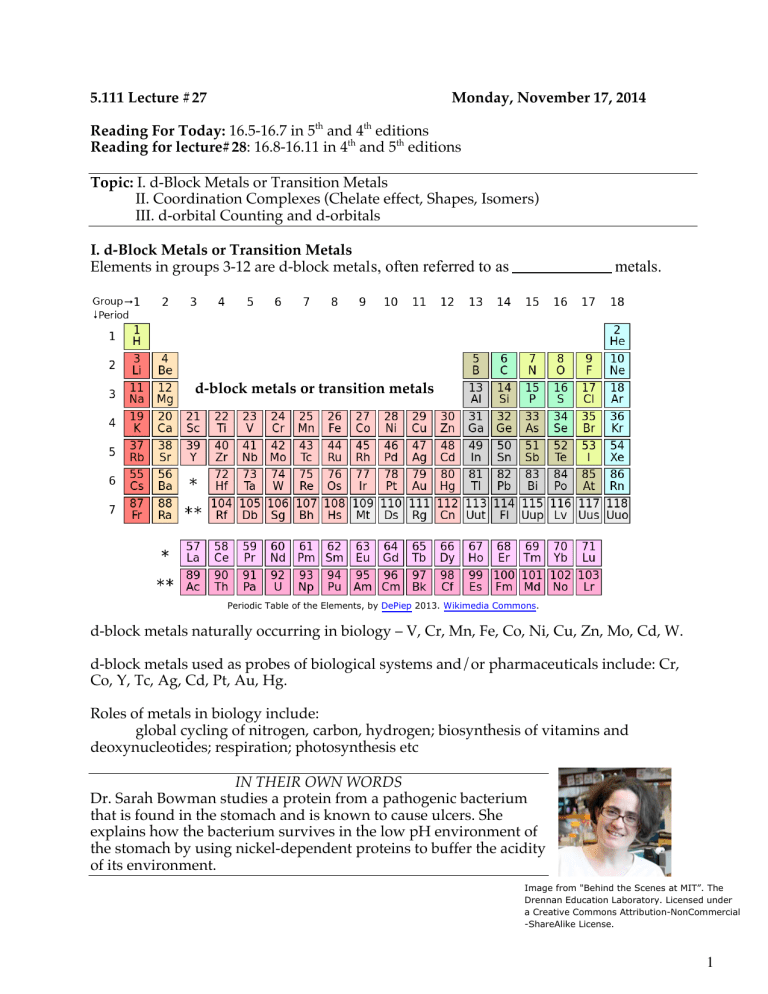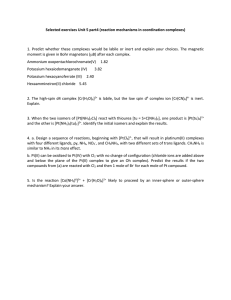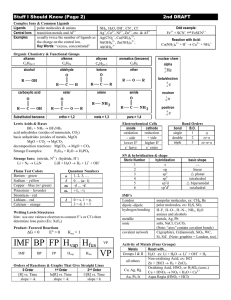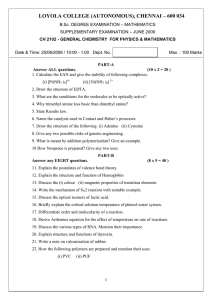
5.111 Lecture #27 Monday, November 17, 2014 Reading For Today: 16.5-16.7 in 5th and 4th editions Reading for lecture#28: 16.8-16.11 in 4th and 5th editions Topic: I. d-Block Metals or Transition Metals II. Coordination Complexes (Chelate effect, Shapes, Isomers) III. d-orbital Counting and d-orbitals I. d-Block Metals or Transition Metals Elements in groups 3-12 are d-block metal s, often referred to as metals. d-block metals or transition metals Periodic Table of the Elements, by DePiep 2013. Wikimedia Commons. d-block metals naturally occurring in biology – V, Cr, Mn, Fe, Co, Ni, Cu, Zn, Mo, Cd, W. d-block metals used as probes of biological systems and/or pharmaceuticals include: Cr, Co, Y, Tc, Ag, Cd, Pt, Au, Hg. Roles of metals in biology include: global cycling of nitrogen, carbon, hydrogen; biosynthesis of vitamins and deoxynucleotides; respiration; photosynthesis etc IN THEIR OWN WORDS Dr. Sarah Bowman studies a protein from a pathogenic bacterium that is found in the stomach and is known to cause ulcers. She explains how the bacterium survives in the low pH environment of the stomach by using nickel-dependent proteins to buffer the acidity of its environment. Image from "Behind the Scenes at MIT”. The Drennan Education Laboratory. Licensed under a Creative Commons Attribution-NonCommercial -ShareAlike License. 1 II. Coordination Complexes A key feature of transition metals is their ability to form complexes with small molecules and ions. Positive metals ions can attract electron density, usually a lone pair of electrons from another atom or molecule to form a coordination complex. Donor atoms are called l igands (Lewis of electrons) NO2Examples of ligands: –typically _______________ one l one pair OCO2-2 CN- SCN- NCS- 2e- 2e- 2e- 2e- OH- OH2 NH3 CO NO+ 2e- 2e- 2e- 2e- 2e- 2e- Acceptor atoms are transition metal s (Lewis _________– _________________ one lone pair of electrons) Examples of transition metals: Ti, Cr, Mn, Fe, Co, Ir, Pt, etc Coordination complexes are composed of metals that are surrounded by ligands. Example: 3+ NH3 NH3 H3N Co H3N NH3 NH3 Coordination number (CN) is the number of ligands bonded to the metal ion. Here CN = 6. ligands comprise the primary coordination sphere. CN numbers typically range from 2-12. Six is the most common. Coordination Complex Notation [Co(NH3)6]+3 3Cl-1 ↓ [Co(NH3)6]Cl3 NH3 within bracket is bound to Co; Cl outside bracket is a counter ion. 2 Structures of coordination complexes (M = Metal, L = Ligand) L L L L M L L M L L CN=6 L L L L M L L L L L L M M L L L CN=5 L L CN=4 M L L L L M L L CN=3 CN=2 Chelates: another name for coordination complexes, from the Greek word for claws. . Ligands _______________ a m etal by binding with one or more sites of attachment Monodentate (one tooth): one point of attachment Bidentate: Tridentate: points of attachment points of attachment Tetradentate : points of attachment Hexadentate: points of attachment Examples of multidentate chelates 1. Vitamin B12. Cobalt is coordinated by a planar tetradentate ligand (corrin ring). It is also coordinated by an upper axial ligand (5'deoxyadenosine) and a lower axial ligand (dimethylbenzimidazole) It’s structure was determined using X-ray crystallography by British Crystallographer Dorothy Crowfoot Hodgkin. She won the Nobel Prize in 1964 for this work and for determining the structure of pencillin. 3 2. Ethylenediamine tetraacetic acid (EDTA). O O HO O CH2 O O O H2C H2C N CH2 HO CH2 N CH2 N CH2 M OH O OH N CH2 Geometry around M is CH2 dentate CH2 H2C O O CH2 O O O EDTA in complex with metal (M) Free EDTA Binding of EDTA is favorable. H 2O H 2O H 2O M 2+ H 2O H 2O H 2O One EDTA H 2O H 2O + M 2+-EDTA H 2O H 2O Six molecules of H2O are released for every 1 molecule of EDTA bound. H 2O H 2O The Chelate Effect refers to the unusually of metal chelates due to the favorable entropic factor accompanying release of non-chelating ligands (usually H2O) from the coordination sphere. Uses of EDTA Isomers Geometric isomers can have vastly different properties. [Pt(NH3)2Cl2] has two geometric isomers H 3N Cl Pt H 3N cisplatin Cl potent anti-cancer drug H 3N Cl Cl Pt NH3 no known function transplatin Only when the Cl ligands on same side (cis to each other) can the molecule bind to DNA. Cisplatin cured Lance Armstrong of cancer. 4 Optical isomers (enantiom ers, images of each other. molecules) are non-superimposable mirror Chiral molecules have different properties in chiral environments (such as a human body). NH3 H 3N NH3 Cl Cl Co OH2 Co NH3 OH2 OH2 OH2 Cl Cl mirror plane III. d-Electron Counting in Coordination Complexes and d-Orbitals d-electron count of metal = group number (periodic table) - oxidation number of metal 1. find oxidation number = for Co in [Co(NH3)6]3+ Hint: NH3 is a neutral ligand 2. d-count is 9 - _____ = _____ Practice with d-counts Complexes [Ni(CO)4] d??? Oxidation number of metal d-count [Co(H2O)2(NH3)Cl3]- 5 d Orbitals There are five d orbitals: dxy, dxz, dyz, dx -y , dz . 2 2 2 You need to be able to draw their shapes. Z Z Y Y X X dz has maximum amplitude along z and doughnut in xy plane dx -y has maximum amplitude along x and y axes. 2 2 2 Z Z Z Y X Y Y X X dyz has maximum amplitude 45° to y and z axes dxz has maximum amplitude 45° to x and z axes dxy has maximum amplitude 45° to x and y axes 6 MIT OpenCourseWare https://ocw.mit.edu 5.111 Principles of Chemical Science Fall 2014 For information about citing these materials or our Terms of Use, visit: https://ocw.mit.edu/terms.






